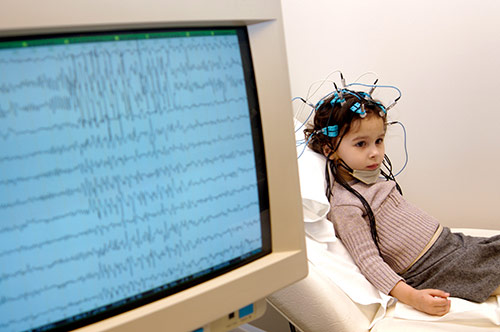
AJPhoto / Science Source
THIS ARTICLE IS MORE THAN FIVE YEARS OLD
This article is more than five years old. Autism research — and science in general — is constantly evolving, so older articles may contain information or theories that have been reevaluated since their original publication date.
Editor’s Note
This article was originally published 3 August 2015, based on preliminary findings presented at the Dup15q Alliance Scientific Meeting. We have updated the article following publication of the study on 15 December 2016 in PLOS One1. Updates appear below in brackets.
Children with an extra copy of the 15q11-13 chromosomal region, the second most common genetic abnormality in people with autism, have unusually strong brain waves called beta oscillations. The preliminary findings, presented Friday at the Dup15q Alliance Scientific Meeting in Orlando, Florida, suggest that beta oscillations could distinguish children with dup15q syndrome from those with autism who do not have the duplication.
Shafali Jeste and her colleagues at the University of California, Los Angeles used electroencephalography (EEG) to record brain waves in [11] children with dup15q syndrome as the children watched a video of floating bubbles [or other abstract images]. For comparison, the researchers used EEG data from [10] children with autism who do not have dup15q syndrome and [9] typically developing controls, collected during previous studies using a similar protocol.
All of the children ranged in age from [1] to 12 years old, [and none were taking medications that can skew EEG measurements]. The children with dup15q syndrome have similar verbal abilities as the children with autism.
The researchers found that children with dup15q syndrome have stronger beta oscillations than do children with autism or controls. “This is striking,” says Jeste. “There’s really no overlap with autism or controls.”
The findings suggest that beta oscillations could serve as a biomarker for 15q11-13 duplications. “One of the biggest challenges is that there are few objective and quantifiable biomarkers that can help us stratify children with a diagnosis,” says Jeste, assistant professor of psychiatry and neurology.
Making waves:
Brain waves reflect the electrical activity of groups of neurons firing in synchrony. Neurons that fire 13 to 30 times per second generate beta oscillations, which tend to occur when a person is alert and actively engaged in a task. Beta oscillations are also known to reflect brain activity that controls body movements.
Beta oscillations increase when people take sedatives called benzodiazepenes, which prolong activation of receptors for the chemical messenger gamma-aminobutyric acid (GABA). Jeste says her colleague, Daniel Geschwind, has found that some children with dup15q syndrome exhibit unusually high levels of genes encoding GABA receptors. These genes reside in the 15q11-13 chromosomal region.
The researchers suggest that increased GABA signaling could help to explain the unusually strong beta oscillations in this group. “That [gene expression] signature has the potential to be linked directly to the EEG signal, which is exciting because we don’t usually see such a mechanistically driven link in autism,” Jeste says.
It’s still unclear how stronger beta oscillations relate to symptoms seen in children with dup15q syndrome. Jeste and her team found that children with the strongest beta oscillations tend to have the most severe autism symptoms. They also tend to have the poorest verbal and motor skills.
The researchers also found that children with dup15q syndrome have more difficulty with fine and gross movements, as well as daily living skills, than do those with autism, but they are more likely to smile appropriately in response to others’ facial expressions.
[During the 2015 meeting, the researchers collected EEG data from an additional 15 individuals with the condition, ranging from 1 to 32 years of age.
Jeste’s team pooled these data with the previously recorded information from the individuals with the syndrome, and compared the strength of beta oscillations across the group. They found that the strength of the signal does not vary significantly with age or the type of 15q duplication, but it tends to be stronger in people who do not have epilepsy than in those who do.]
Together, the findings suggest that EEG can help to identify children with dup15q syndrome, who may benefit from different treatment approaches than children with autism. “The overarching goal of all of this is to design and implement targeted, mechanism-based treatments,” Jeste says.
For more reports from the 2015 Dup15q Alliance Scientific Meeting, please click here.
By joining the discussion, you agree to our privacy policy.